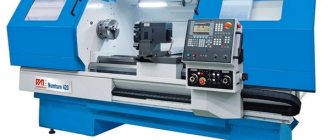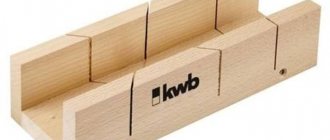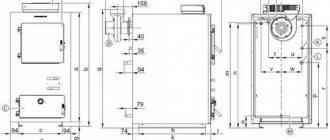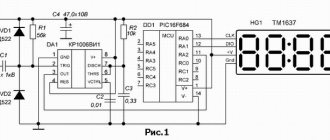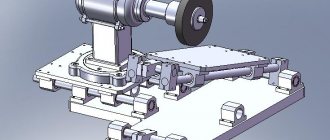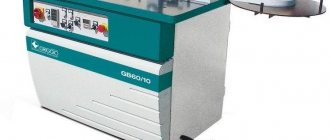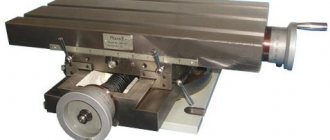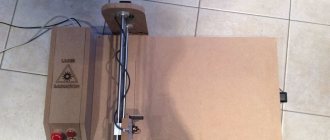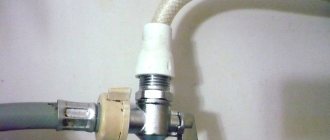Omsa socks set
349 ₽ More details
Omsa socks set
349 ₽ More details
Jigsaw files for wood
One of the important advantages of plexiglass is its flexibility. However, in order to accurately bend the sheet, you first need to warm it up properly. In this material we will look at what equipment exists for bending plexiglass, what conditions must be observed when using it, and how to make such a machine with your own hands.
Techniques
There are several ways to bend plexiglass. When choosing a method, you need to focus on the size of the sheet and the desired type of bend.
String
This method is used to obtain products with straight lines: price tags, stands, display cases, etc.
In this case, the sheet is bent using a nichrome string connected to a power source, at a rate of about 1 kW per 1.2 m of wire. When the heating element is heated, a sheet is brought to it at the place where it will be folded. The material heats up and quickly acquires plasticity, after which it is bent at the desired angle and fixed with a support and weight until it cools.
A nichrome string acts as a heating element, with the help of which plexiglass is bent
This method has a number of disadvantages:
- When heated, the string may sag, causing the future bend line to turn out uneven. To solve this problem, some people attach an additional weight to the wire.
- If the heating occurs too quickly, one side will soften, and the other will remain relatively cold, resulting in “steps” instead of a smooth bend.
- On old wire, individual sections burn out, causing heating to become uneven.
Temperature
Thermal bending is the heating of a specific area of material, not necessarily in the form of a line. For this purpose, both special machines and improvised means are used. The latter are more suitable for small sheets. The following methods are popular:
- Construction hairdryer. A bend line is marked on the plexiglass and heated with air flow. After this, the sheet is bent at the desired angle.
Plexiglas, heated with a hair dryer, is easily bent into the desired shape - Boiling. The sheet is completely immersed in boiling water, then taken out and given the desired shape. This method is not suitable for creating clear lines.
By radius
This method is used for large sheets. The curves are smooth.
The work is carried out as follows: a large metal pipe is securely fixed and heated to 90–100 °C. A sheet of plexiglass is treated with soda, secured to the pipe using clamps and carefully wrapped around it. The workpiece cools down there.
Uses a metal pipe as a device to create smooth bends of plexiglass
Note! The metal must be clean and unpainted.
Plastic bending processes
PET bending in St. Petersburg is carried out using two methods:
- on a string;
- using equipment (thermal designers).
Manufacturing of products on string
It is one of the most widely used thermoforming processes. The technology is ideal for sheets with a thickness of 0.8 - 1.0 cm. Deformation occurs at the desired angle.
The main tool for the process is a nichrome string connected to the mains. It performs 2 functions: it serves as a heat source and a guide for the bending line. During operation, the string heats up and heats the workpiece in a straight line. The material at the place of heating softens and becomes plastic, which allows it to be bent in the desired direction. After cooling, the product retains its properties and original strength.
Bending plastic products on a string requires compliance with the temperature regime for each type of polymer. For example, for acrylic the heating range is 160 – 175 °C, for polycarbonate 150 – 190 °C.
Bending on thermal designers
It is advisable to use thermal designers for the production of a large number of polymer semi-finished products. The operating principle of the machines is the same as on a string, and the quality is similar, but thermal designers have some advantages:
- copes with bending of thick sheets thanks to double-sided deep heating;
- provides high speed and, consequently, productivity.
Review
Now let's look at professional machines for bending plexiglass.
S-Master 1000
The main advantage is the ability to install additional heating lines, and each of them can be configured separately. It is possible to heat the sheet on both sides.
The device is connected to a 220 V network and consumes only up to 0.8 kW.
There are several types of configuration:
- ST – standard. The set includes 2 main heating lines, a mini-table 8 cm wide, a stop-conductor, as well as 2 spare strings of 1 m each. There is a digital timer with sound and light notification.
- M. The kit includes only 2 heating lines and 2 strings.
- ST-M. The standard equipment is equipped with two more lines.
- ST-M-2X. The set includes 4 heating elements and an upper frame for double-sided heating.
- ST-2M. The set includes 6 lines, otherwise it corresponds to the standard one.
- ST-3M. Standard with 8 heating elements.
- ST-3M-2X. Basic set with 8 lines and top frame.
The S-Master 1000 is an excellent machine for working with plexiglass; the main advantage is the ability to add modules.
If the standard width of one mini-table is not enough for comfortable work, it can be equipped with additional ones, obtaining a working surface of up to 40 cm. The working surface and stop can be adjusted, fixing in the desired position using screw clamps.
It is possible to operate in a gentle mode: the strings heat up less, which extends their service life.
This is how you work with this device:
- Place the work surface in the desired position. To do this, first loosen the screws.
- Make sure the thermostat is set to zero. Turn on the device. Set it to gentle heating mode for 1.5 minutes.
- Switch to work mode and install the plexiglass part on the work element. Start the timer. The instructions indicate how long it takes to warm up a sheet of one thickness or another.
- After warming up, bend the workpiece at the desired angle.
Before processing, practice on an unnecessary piece so as not to spoil an expensive part. Adjust heating time or other parameters as necessary.
HRT
With this device you can bend not only plexiglass, but also polycarbonate, polystyrene and other types of plastic with a thickness of 1 to 8 mm. The device is suitable for making relatively small objects, but with many complex bends.
The HRT machine is great for creating plexiglass parts with many complex curves
Power up to 1 kW per line.
The package includes 2 threads with separate adjustment. Installed in a reflective profile, which eliminates the need for water cooling. The number of threads can be increased to 4.
The height of the lines can be adjusted. They are secured in the required position with a limit bar.
There is no timer. Recommendations for calculating heating time are in the instructions.
The process of working with the device is as follows:
- Use the instructions to calculate the optimal warm-up time.
- Place the threads in the desired position and turn on the device. Set the temperature for each heating element.
- Secure the sheet in the desired position and note the time.
- After softening the desired area, remove and bend the part.
HR
The HR series machine for processing plexiglass is well suited for a private workshop due to its compact size.
The HR series is a compact, easy-to-assemble and easy-to-use machine. An excellent choice for a private workshop. Even the simplest of devices provides high bending accuracy. Softening of the material occurs strictly in the treated area.
The thickness of the sheets can be from 1 to 6 mm. Some models have a special option for processing thinner sheets.
Power depends on the model and can range from 225 to 1000 W. The food is standard, from a 220 V network. The length of the tables is from 0.5 to 3 m.
The standard kit includes 1 filament located in the reflector, with adjustable temperature and height. There is usually no possibility of additional staffing.
Work process:
- Set the thread at the desired height.
- Calculate and set the desired temperature on the thermostat.
- Install and warm up the sheet.
HRK
A series of semi-automatic devices designed for double-sided heating. Allows you to process sheets up to 20 mm.
The HRK machine is capable of processing plexiglass sheets with a thickness of 20mm
The power of models with 4 heating lines is 1000 W, 8 lines are 3200 W. The length of the tables ranges from 0.65 to 1.25 mm. The threads are installed in reflective profiles.
All devices have a timer. Thanks to the modular design, they are easy to disassemble and assemble. Additional equipment is possible.
The temperature of each thread can be adjusted separately. The heaters are easily adjustable in height. They can be moved in both the lower and upper planes.
The upper frame is controlled using a pneumatic drive.
Warming up is carried out according to the standard scheme. The upper part is additionally adjusted using a special pedal.
The upper frame of plexiglass processing machines is controlled by a pneumatic drive
How to make a machine with your own hands
You can make a machine for processing plexiglass with your own hands. Skills in working with metal and electronics are required, as well as purchasing a number of parts, but the device will be of the appropriate size and configuration.
Step-by-step instruction
The machine is made like this:
- Calculate the body dimensions that are convenient for you. For a small workshop, the optimal choice would be a frame of 70x70x30 cm.
- Cut sections of the required length from a 2x2 cm profile pipe and weld the frame.
- Powder coat the frame. Weld ears for channels, that is, guides for threads, to its upper part.
- Make channels, preferably from aluminum, and weld them to the frame.
It is advisable to make the channel for attaching the machine frame from aluminum, since this metal is light and flexible - Cut and weld two more pipes to install the control unit.
- Cut out a metal housing for the control unit. Make holes in it for buttons and air circulation. Paint it and secure it to the frame. Approximate size – 30x30x12 cm.
- Make a stop bar for the workpieces. To do this, insert the corner into the channel and rivet it. The corner should be 2–3 mm higher than the channel ribs.
- Cut a piece of nichrome wire to the required length and a channel 20 cm longer.
- Fix one end of the wire motionless to the edge of the channel, and screw the textolite strip to the other.
- Take a spring with a long stroke, for example from the gas pedal of a VAZ 2106. Using it, pull the bar to the opposite end of the channel.
- The power supply wire must be flexible, two-core, double insulated. Hide it in a rubber tube. Screw one of its cores to the heating element, the second to the channel.
- Prepare the power source. To do this, you can use a pulse device with parameters of 350 W and 24 V. It is enough for two lines. Before installation, you need to unsolder the standard adjusting resistance, which is located near the voltage terminals. Instead, you need to solder a two-wire wire.
To power a plexiglass processing machine, it is highly advisable to use a switching power supply - At the other end of the wire, you need to solder the same resistance under the handle as was in the device. It is fixed to the control unit.
- Attach the fan to the control unit housing. It should be located next to the pre-made holes. Attach the power supply to the same case.
- You can add a timer to the device. The factory one will do, you just need to purchase an additional connector for the wires. To sound an alarm, attach a regular doorbell to it.
- To turn on the power, you can use a 6A circuit breaker. In addition, it plays the function of a fuse.
- To control each heating element separately, connect two buttons to the unit panel. The internal light bulbs must be carefully removed and replaced with LEDs with a resistance of 2 kOhm.
Ready!
Nuances of work
Before you start using homemade equipment, carefully check the reliability of the assembly, especially in terms of electrical wiring. Observe safety precautions when working with heating elements.
Be sure to check the reliability of the assembly of the machine and adhere to safety precautions when working with it
To ensure a high-quality product, consider the following nuances:
- Extruded glass melts at about 160°C, while cast glass melts at about 180°C. It is important not to overheat the material to these temperatures, otherwise the sheet will turn into a shapeless mass.
- Shrinkage may occur when working with extruded plexiglass. To avoid this, bend the sheet only across the extrusion line.
- Before starting work, make sure that the sheet being processed is completely dry, otherwise bubbles will appear at the fold.
- To prevent the plexiglass from cracking, the heating zone must be no less than 3 times the thickness of the sheet itself.
- When working with a very thin plate, first wrap it in non-flammable material.
- Do not try to forcefully cool the sheet by placing it in water, under air conditioning, etc. Cooling should be gradual.
You can make many things from plexiglass - from furniture to figurine.
A bending machine, whether homemade or branded, will open up additional opportunities for you and allow you to make money by selling your products.
Homemade machine for bending plexiglass
Authorization on the site
How to make a simple machine for bending plexiglass with your own hands.
To make my own homemade products, I have long been planning to assemble a small machine for bending plexiglass and plastic.
A case helped: they asked me to make a stand for a paper sheet of A4 size.
When making products from plexiglass, acrylic or plastic, nichrome thread is used. So I assembled a small machine and used an electric spiral. tiles

